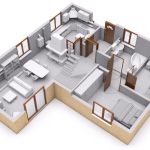A Beginner’s Guide to Reading and Understanding Floor Plans
 A Beginner’s Guide to Reading and Understanding Floor Plans
A Beginner’s Guide to Reading and Understanding Floor Plans
If you are planning to buy or rent a new home, understanding floor plans is an essential skill. A floor plan is a scaled diagram that shows the arrangement, dimensions, and layout of a building’s rooms, walls, doors, and windows. It provides a bird’s-eye view of the property, helping you visualize how the space is organized and how you can utilize it. In this beginner’s guide, we will explore the key elements of floor plans and some essential tips for reading and understanding them.
1. Introduction to Floor Plans
Before we delve into the details, let’s start with a brief introduction to floor plans. As mentioned earlier, a floor plan is a two-dimensional representation of a property from above. It typically includes walls, doors, windows, furniture, appliances, and other fixtures. Floor plans allow you to assess the traffic flow within the space, visualize furniture placement, and understand room sizes and dimensions.
2. Understanding the Scale
One of the fundamental aspects of reading a floor plan is understanding the scale. Floor plans are typically drawn to scale, meaning they represent accurate proportional relationships between objects and spaces. The scale is usually indicated in the legend or key provided on the plan. It is crucial to pay attention to the scale to have an accurate understanding of the layout and dimensions of the space.
3. Exploring Room Layouts
When looking at a floor plan, it is essential to understand the different room layouts. The layout of rooms can greatly impact the functionality and flow of your living space. Common room layouts include open concept, where multiple spaces flow seamlessly, or closed-off rooms, offering distinct and separate areas. Consider your personal preferences and lifestyle when assessing the room layouts in a floor plan.
4. Identifying Room Functions
Each room in a floor plan serves a specific purpose. Understanding the function of each room will help you assess if the space meets your needs. Common room functions include bedrooms, bathrooms, kitchen, living room, dining room, and home office. With this knowledge, you can evaluate if the floor plan aligns with your lifestyle and requirements.
5. Analyzing Traffic Flow
Another crucial aspect of reading a floor plan is analyzing the traffic flow within the space. Traffic flow refers to how people will move throughout the property, from one room to another. A well-designed floor plan will have a logical flow that minimizes unnecessary walking or disruptions. Assess if the floor plan provides easy access between rooms and if it suits your family’s daily routines.
6. Assessing Room Sizes and Dimensions
Understanding the actual size and dimensions of each room is vital. This information helps you determine if your furniture will fit comfortably and if the space satisfies your requirements. Pay close attention to room measurements, including ceiling height, doorways, and windows. This will prevent any surprises or disappointments when you finally move into your new home.
7. Evaluating Natural Light and Ventilation
Lighting and ventilation are crucial factors in creating a comfortable living environment. When reading a floor plan, evaluate the placement and size of windows. Consider how natural light will enter the space and if there are opportunities for cross-ventilation. Properly positioned windows can enhance the overall ambience and energy efficiency of your home.
8. Noting Storage Spaces
Storage is an essential aspect of any home. As you read a floor plan, identify and evaluate the available storage spaces. Look for closets in bedrooms, pantry space in the kitchen, and storage areas in other parts of the house. Sufficient storage is essential for keeping your home organized and clutter-free.
Summary
Reading and understanding floor plans is a critical skill when searching for a new home. By familiarizing yourself with the basics of floor plans, such as scale, room layouts, room functions, and traffic flow, you can make informed decisions about your future living space. Remember to pay attention to room sizes, natural light, ventilation, and storage spaces when assessing a floor plan. With these insights, you will be better equipped to choose a home that perfectly suits your needs and lifestyle.
Got Questions? Let Us Help!
Smalley General Contracting is a locally owned and operated general contracting company that was established in 2006. We pride ourselves on our ability to complete any project we take on from start to finish! We handle new construction of homes from the point of design, all the way through to completion. At Smalley General Contracting we provide a wide array of services to our clients in the construction field. We are able to handle building design, new construction, lot preparation and development. We also take of remodeling projects, bathrooms, kitchens, additions and concrete projects. Come see what sets us apart from the competition, and see what we can do for you. Contact us today for your free estimate!
More...
Categorised in: Floor Plans





